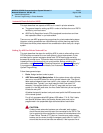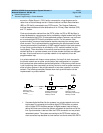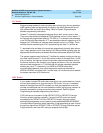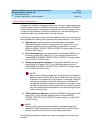
MERLIN LEGEND Communications System Release 6.1
Network Reference
555-661-150
Issue 1
August 1998
Network Management
Page 5-6General Programming in Private Networks
5
Programming.
For guidelines on setting up remote access COR settings, see
“Remote Access Default Class-of-Restriction Settings” on page 6
.
The remote access Automatic Callback setting of on or off does not apply to
private network calls. Automatic Callback can be used at users’ local system
when all private networked trunks are busy.
Change the factory-set outward and toll restrictions on the private network trunks
to allow ARS calling over the private network and to allow UDP extension calls to
pass through the system. Necessary restrictions on PSTN trunks must be
imposed by the system manager at the non-local system(s). Calling restrictions
can and must still be applied to remote access barrier codes.
You should use the default remote access COR setting to assign the factory-set
Disallowed List 7 to all tie and/or all non-tie tandem trunks. This Disallowed List
prevents 900 and 976 calls, for example, as well as other types of calls frequently
made by people who commit toll fraud. You may wish to add to this list if required
by your organization’s security needs. Do not assign any Allowed List to the
default remote access COR.
Clock Synchronization 5
Whenever digital signals are transmitted over a communications link, the
receiving end must be synchronized with the transmitting end to receive the digital
signals without errors. The system synchronizes itself by extracting a timing signal
from an incoming digital stream. All the digital facilities operate from a common
clock. This is called
clock synchronization.
The programming procedure for clock
synchronization, described in
System Programming
, does not change for a
system in a private network. However, in a private network, the tandem facilities
connected to a system may require special planning for the best possible clock
synchronization.
Primary synchronization of digital signals is backed up, in case of failure, by
secondary and tertiary clock synchronization specified in system programming.
This is important when a system has more than one digital facility. When a module
or port is taken out of service for maintenance or its signal is otherwise disturbed,
other digital facilities in a system still must be synchronized.
NOTE:
If a T1 facility goes out of service at a remote system, the local MERLIN
LEGEND system automatically switches its T1 clock synchronization to a
secondary source (if one is programmed). When the T1 facility is restored,
the local MERLIN LEGEND does not automatically switch the clock
synchronization to the primary source; clock synchronization can be
manually changed from the secondary source to the primary source.
As in a standalone system, a private networked system must derive clock
synchronization from an in-service facility, not an unused or idle port. The best


















